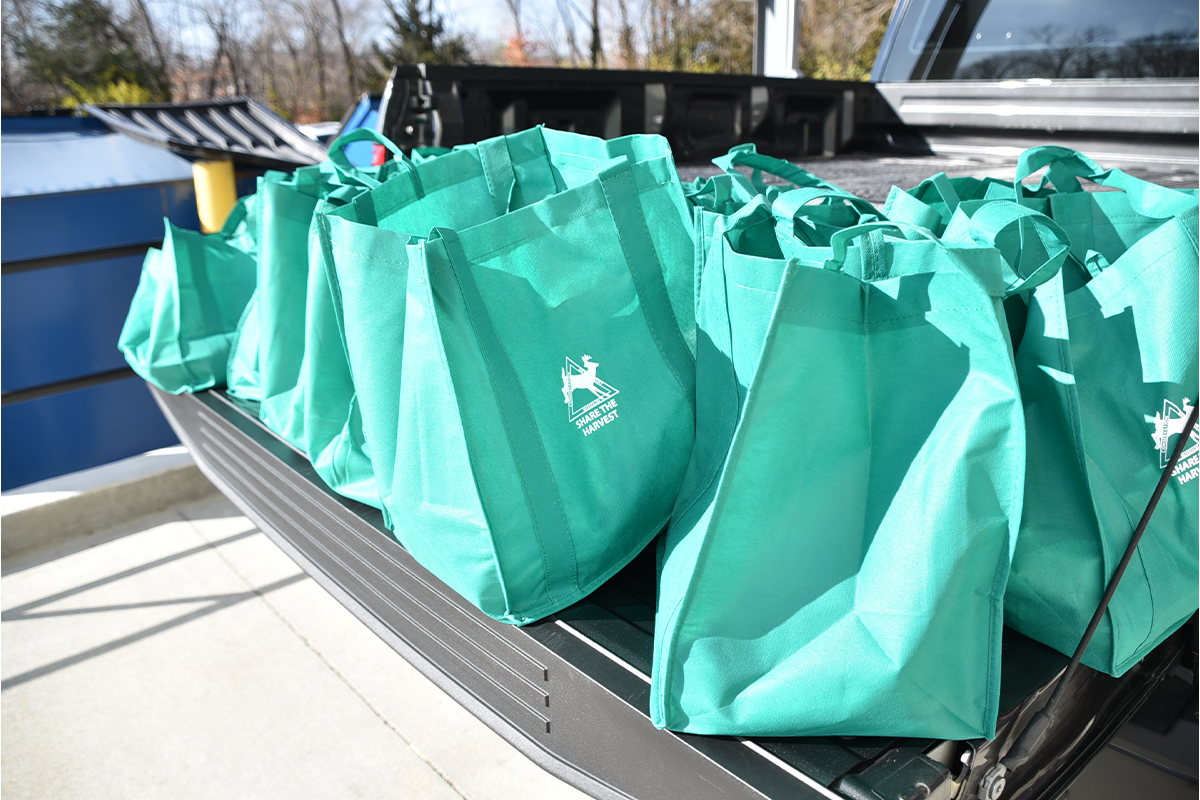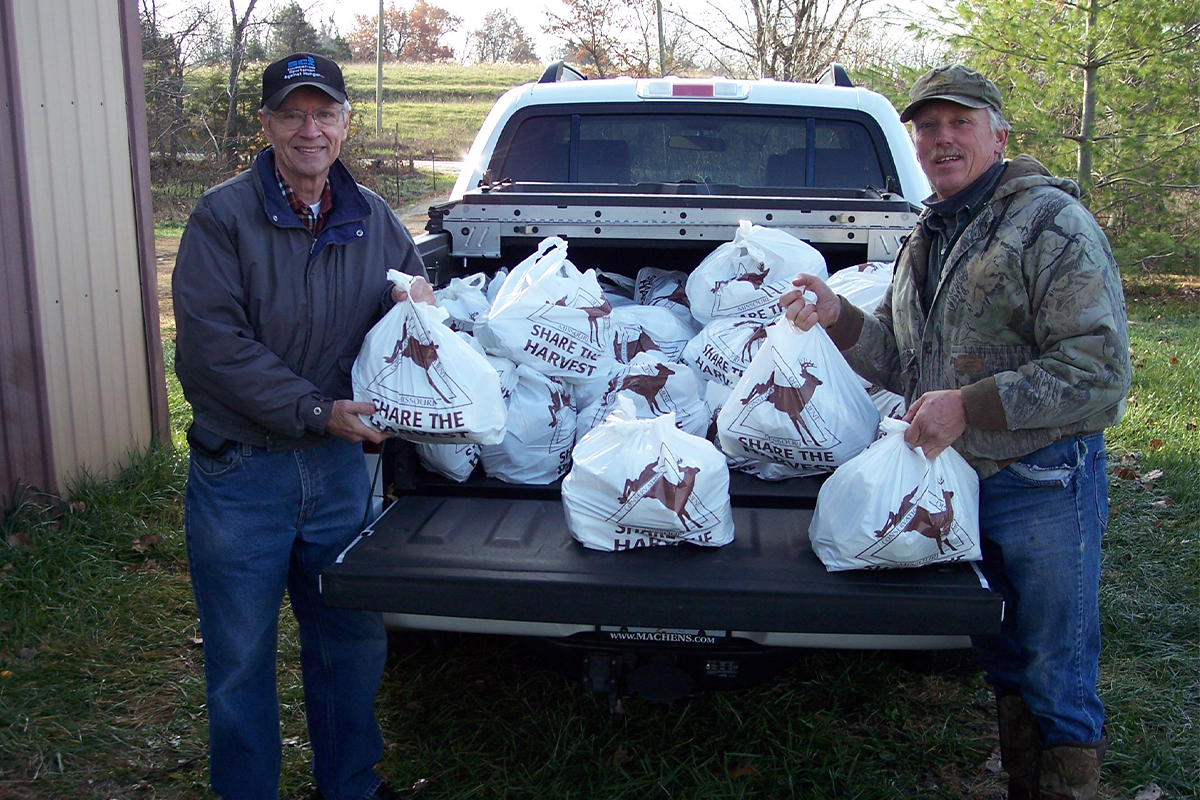The initiative of a small group of archery hunters spurred the creation of a program that has run strong for over three decades, feeding hungry people in the state of Missouri through deer meat donations. In 1992, the Conservation Federation of Missouri (CFM), in partnership with the Missouri Department of Conservation (MDC) and Feeding America, began the statewide Share the Harvest program based on the hunters’ philanthropic idea.
“This program is unlike any other program we help with here at MDC, as it reaches so many Missouri citizens that are genuinely in need,” said Caleb Sevy, the protection program specialist at MDC.
To ensure the program continues to be as successful as it has been, the participation and cooperation of three parties are necessary. Perhaps most importantly, Share the Harvest relies on hunters who are willing to donate their game to food banks rather than stocking their own freezers with meat from successful hunts. Missouri-based meat processors are also needed to donate a portion of their business and meat processing capacity to benefit local communities. Almost 100 meat processing operations now partner with Share the Harvest. The final group that makes this program a success is the food banks that store and distribute donated, processed venison.
“The Conservation Federation of Missouri has proudly administered the program for over 30 years,” said Tyler Schwartze, CFM executive director. “With the help of so many partners, like the Missouri Department of Conservation, Feeding Missouri and all food banks, along with the citizen hunters that generously donate venison each season, we are able to help our neighbors in need.”
Handling the logistics and communications, the CFM and MDC connect one party to the next and ensure that the meat delivered to doors is safe to eat.
“When you speak with the local distributors about what this program means to their communities, you cannot help but be proud of what we have accomplished so far, but at the same time be humbled by the overwhelming need of the community,” Sevy said. “It is the humbling feeling that I think provides the motivation to continue to grow this program as much as possible and makes me proud to be a part of it.”
Local support
The program wouldn’t be feasible without support from sponsors. Through their funding, the bulk of meat processing costs are covered. Processors receive $75 per deer processed for the program, however that amount falls well short of their cost for processing.
It’s up to each Missouri processor to decide how to handle the remaining costs for their operation. Some ask the hunters who are donating deer to cover the rest of the fee, which equates to around $15. Others have found additional sponsors in their local communities to financially support the company’s Share the Harvest endeavors.
Oldfield Packing LLC, Sparta, Mo., didn’t have to look far for sponsorship. In fact, someone came knocking on its door.
The electric cooperative White River Valley approached Oldfield Packing officials saying it would be willing to pay any extra processing fees.
“They have a foundation, what they call their round-up money that they use for all sorts of things, like scholarships,” said David Walker, owner of Oldfield Packing. “They’re all the time helping somebody with something, you know what I mean? It’s really a good thing because they’ve got that money, and they’re willing to use it for this program.”
The Perryville, Mo., community similarly rallied around the Share the Harvest program through financial support. Tyson Wibbenmeyer, owner of Stonie’s Sausage Shop, Perryville, Mo., said all extra fees have been covered by local businesses since the inception of the program.
“We have a great community here in Perryville that got behind the program as well and started soliciting funds locally that offset the rest of it.”
The funding alleviated any burdens that otherwise would have been placed on hunters. With the coverage, hunters face one less obstacle to donate deer to feed the hungry.
“The VFW, the American Legion, the Sportsman’s Club here in town — all those organizations got together, threw more money at it to offset the cost to the hunter,” Wibbenmeyer added. “So, it’d be free to the hunter if they wanted to donate a deer — kill an extra deer to fill a tag. If they didn’t really need one in their freezer, but they enjoyed hunting and wanted to participate in that program, they could do that no cost to them.”
 Any non-profit charitable organization that is able to store the meat and agrees to deliver uncooked venison directly to families or individuals is able to distribute the donations. (Source: Conservation Federation of Missouri)
Any non-profit charitable organization that is able to store the meat and agrees to deliver uncooked venison directly to families or individuals is able to distribute the donations. (Source: Conservation Federation of Missouri)Side op
Processors said the deer donations have had minimal effect on their business routine. Regardless of donations, Missouri meat processors are running full throttle when hunting season comes around. The key to keeping up with demand is organization.
“That time of year when you start the deer processing, it’s really a touchy time,” Walker said. “It’s a lot of keeping track of things. You’re dealing with hundreds of people on a weekly basis, where normally you’re dealing with around 25 head of beef.”
With close to 800 deer processed per year, Oldfield Packing has its work cut out for it, but it still manages to make time, and room, for Share the Harvest donations. Oldfield estimated it processed around 75 deer for the program last year, which is about average for the business.
Walker added, “The work isn’t so bad as long as we can keep track and make sure everything goes smooth.”
Kahoka Meat Processing & Deli, Kahoka, Mo., reported similar numbers, with 74 deer processed for Share the Harvest in 2022. The company noted that it has processed up to 100 deer in the past, and its overall totals outside the program average 400 to 500 deer annually.
To adjust for the influx of game during deer season, Kahoka hires extra personnel for that period.
“Whenever deer season rolls around, we don’t shut down doing our beef and pork during the bow seasons until we get to the rifle season,” said Eric Young, butcher of the family-owned and operated Kahoka Meat Processing. “That’s when we shut down completely, and we’re just doing nothing but the deer for about three weeks.”
According to CDM’s records, nearly 5,000 deer were donated across the state of Missouri in 2022, which was the equivalent of 235,000 lbs of ground venison. Since the program’s inception, it has harvested 4.3 million lbs of venison that has been distributed to hungry Missourians.
Food security
The main obstacle for processors participating in Share the Harvest comes from chronic wasting disease (CWD), which has become a concern for the MDC and CFM as state deer herds have been found to contract the disease.
“The activity testing has thrown a little bit of complexity into that program because now the deer has to be tested for CWD,” Wibbenmeyer noted.
Processors are careful to store any donated deer separate from other game so that it can be tested. Only in certain counties known as hot zones where CWD is prevalent do processors need to take these precautions.
Because Kahoka Meat Processing falls within the 25-mile radius of a hot zone, the company is required to test all donated deer for the disease.
“You just have to take samples out of each deer,” Young explained. “That’s a little bit more work to do, but it’s a pretty simple process.”
To test for CWD, processors pull out the lymph nodes from the deer’s neck and send those samples to the MDC. The meat is held until MDC confirms the results. Any meat testing positive is immediately disposed of and removed from the supply chain.
The venison safe for consumption is ground and contained in 1- to 2-lb packages that are frozen and stored until a nearby food bank picks up the meat. Share the Harvest program funds pay for the packaging, which features a deer and the program logo.
Feeding Missouri, a coalition of food banks across the state, partners with the CFM and MDC to distribute the venison once processors finish grinding and packaging the meat.
While food banks are the most common means of distributing the donations, Sevy noted that any non-profit charitable organization that is able to store the meat and agrees to deliver uncooked venison directly to families or individuals is able to distribute the donations.
“Most of the feedback we receive and the ‘thank you’ notes we get come from the pantries and organizations that distribute the donation,” Sevy said. “They are very grateful for Missouri hunters and their donations and always inform us that the donation flies off the shelf as quickly as it arrives.”
The need isn’t only present in Missouri. As a testament to the high demand for venison donations, most states have created similar programs for hunters to donate deer to local food banks. The nationwide effort to share the harvest with those in need invites everyone to give back to their communities, whether through recreational hunting and deer donations, through operational capabilities like meat processing and distribution, or through financial support to contribute to the program’s funds.
“I think it’s great that we got behind it and that the community gets behind it,” Wibbenmeyer said. “It’s kind of a feel-good thing, where I’m glad that we’re a part of it — that we got the opportunity to be a part of it.”



